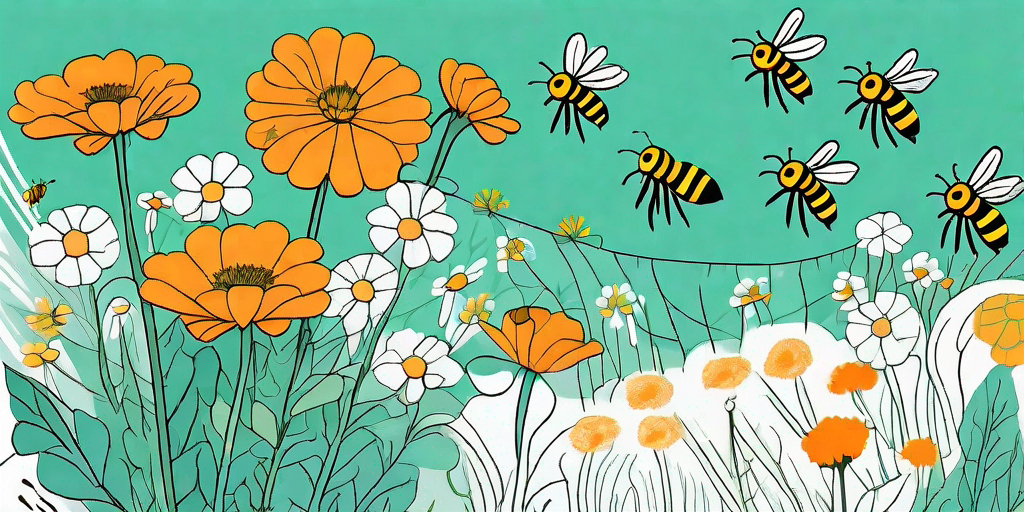
Welcome, dear reader, to the fascinating world of bees and marigolds. In this grand adventure, we'll delve into the intricate relationship between these buzzing creatures and these vibrant flowers. Fasten your seatbelts, or rather, your gardening gloves, as we embark on this journey of discovery.
The Buzz about Bees
Bees, those tiny buzzing creatures that make some of us run in fear, are actually quite the marvels of nature. They are the unsung heroes of our ecosystem, playing a crucial role in pollination. Without them, our plates would be rather dull, and our world a lot less colourful.
There are over 20,000 species of bees, each with their own unique traits and behaviours. From the industrious honeybee to the solitary carpenter bee, these creatures are as diverse as they come. But one thing they all have in common is their love for nectar and pollen, which brings us to our next point of interest - marigolds.
Marvellous Marigolds
Marigolds, with their vibrant hues of orange, yellow, and gold, are a sight to behold. But their appeal goes beyond their aesthetic value. These flowers are known for their strong, pungent scent and their ability to repel certain pests, making them a favourite among gardeners.
But what makes marigolds truly special is their relationship with bees. These flowers are like the bee's knees of the plant world, attracting these pollinators like no other. But why is this the case? Let's find out.
The Bee-Marigold Connection
Why Bees Love Marigolds
Bees are attracted to marigolds for a number of reasons. First, the bright colours of marigolds are like a beacon for bees. Bees see in the ultraviolet spectrum and are drawn to flowers that reflect a lot of UV light, like marigolds.
Second, marigolds are rich in nectar and pollen, the bee's favourite food. The flowers' shape also makes it easy for bees to access these treats. It's like a buffet that's open all day, every day!
The Benefits for Marigolds
Marigolds, in turn, benefit from the bees' visits. When a bee lands on a marigold, it brushes against the flower's anthers and gets covered in pollen. When the bee visits another flower, some of this pollen rubs off, leading to cross-pollination. This helps the marigolds reproduce and spread.
So, it's a win-win situation for both parties. The bees get their food, and the marigolds get to propagate. It's like a perfect love story, isn't it?
Planting Marigolds to Attract Bees
Choosing the Right Marigolds
Not all marigolds are created equal when it comes to attracting bees. Some varieties, like the French marigold, produce less nectar and are less appealing to bees. On the other hand, African marigolds and pot marigolds are bee magnets.
So, if you want to attract bees to your garden, choose your marigolds wisely. And remember, the more marigolds you plant, the more bees you'll attract.
Planting and Care
Marigolds are easy to grow and care for, making them perfect for novice gardeners. They prefer full sun and well-drained soil. They're also drought-tolerant, so you don't need to worry about watering them too often.
When planting marigolds, space them about 10 to 12 inches apart to allow for proper air circulation. And don't forget to deadhead spent flowers to encourage more blooms. More flowers mean more bees!
FAQs
- Are marigolds harmful to bees?
No, marigolds are not harmful to bees. In fact, they provide bees with a rich source of nectar and pollen.
- Can marigolds attract other pollinators?
Yes, marigolds can also attract butterflies and other beneficial insects to your garden.
- Do marigolds bloom all year?
Marigolds are annuals, meaning they bloom for one season. However, in warmer climates, they can bloom almost all year round.
Conclusion
So, there you have it, the beautiful relationship between bees and marigolds. It's a tale of mutual benefit and coexistence, a testament to the wonders of nature. So, the next time you see a bee buzzing around a marigold, take a moment to appreciate this intricate dance of nature.
And who knows? Maybe you'll be inspired to plant some marigolds in your own garden and become a part of this wonderful story. After all, every garden could use a bit more buzz!















